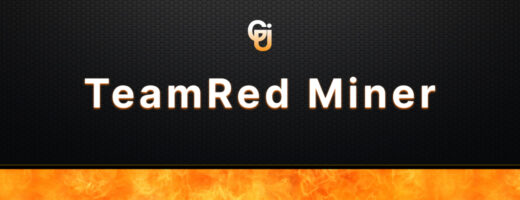- All about NBMiner
- Download NBMiner
- Installing NBMiner: Steps and Recommendations
- Setting: Operating parameters and optimum values
- Breaking Down the Key Features of NBMiner
- Table showcasing the supported algorithms and associated fees for NBMiner:
- Optimizing Performance: Useful Tips
- Connecting to Mining Pools with NBMiner: A Step-by-Step Guide
- Resolving Issues and Frequently Asked Questions about NBMiner
- Recent NBMiner releases and updates: What’s new?
- NBMiner v42.3
- NBMiner v42.2
- NBMiner v42.1
All about NBMiner
NBMiner is a popular mining software used by cryptocurrency enthusiasts and miners around the world. It is designed to optimize mining performance and maximize the efficiency of GPU-based mining rigs. Developed by a team of experts, NBMiner is known for its versatility and compatibility with various cryptocurrencies, including Ethereum, Ethereum Classic, Ravencoin, Grin, and many others.
One of the key features of NBMiner is its focus on performance optimization. It utilizes advanced algorithms and techniques to ensure that miners can achieve the highest possible hash rates and mining rewards. By fine-tuning GPU settings and optimizing memory usage, NBMiner aims to provide miners with a competitive edge in the highly competitive cryptocurrency mining landscape.
Moreover, NBMiner supports a range of mining algorithms, allowing users to mine different cryptocurrencies using the same software. This flexibility makes it a valuable tool for miners who want to diversify their mining activities or switch between cryptocurrencies based on market conditions.
In addition to its performance-oriented features, NBMiner also offers a user-friendly interface that simplifies the mining process. The software provides detailed statistics and real-time monitoring of mining activities, allowing users to track their hashrates, temperatures, and power consumption conveniently. It also supports remote monitoring and management, enabling miners to control their rigs from anywhere using a web interface or mobile app.
NBMiner has gained a reputation for its stability and reliability, with regular updates and bug fixes provided by the development team. The software is compatible with both Windows and Linux operating systems, catering to a wide range of mining setups.
It’s worth noting that NBMiner is a closed-source software, meaning that its code is not publicly available for review or modification. While some miners prefer open-source solutions for transparency and security reasons, NBMiner has built a strong user base due to its consistent performance and user-friendly interface.
Overall, NBMiner is a powerful mining software that combines performance optimization, versatility, and ease of use. Its robust features and compatibility with various cryptocurrencies make it a popular choice among cryptocurrency miners, particularly those in the United States and other parts of the world.
Download NBMiner
Installing NBMiner: Steps and Recommendations
NBMiner is a highly regarded mining software utilized by cryptocurrency enthusiasts and miners worldwide. If you’re interested in setting it up, follow these steps and recommendations to get started.
- Download NBMiner: Choose the appropriate version for your operating system, whether it’s Windows or Linux.
- Extract the Files: Once the download is complete, locate the downloaded file and extract the contents to a folder on your computer. This step is necessary to access the NBMiner executable and related files.
- Configure Mining Settings: Before launching NBMiner, it’s essential to configure the mining settings specific to your setup. Open the configuration file provided with NBMiner and input the necessary details such as your mining pool address, username, password, and any other relevant information.
- GPU Optimization: To maximize your mining performance, it’s advisable to optimize your GPU settings. This can be done through various methods, including tweaking power limits, adjusting memory clock speeds, and fine-tuning fan curves. Consult your GPU manufacturer’s guidelines or refer to online resources for specific recommendations on optimizing GPU settings.
- Launch NBMiner: Once you have customized the mining settings and optimized your GPU, you are ready to launch NBMiner. Locate the NBMiner executable file in the folder where you extracted the downloaded files. Double-click on it to launch the application.
- Monitor Mining Activity: NBMiner provides real-time monitoring of your mining activity, including hashrates, temperatures, and power consumption. Keep an eye on these metrics to ensure everything is running smoothly. You can also access advanced statistics and additional features through NBMiner’s user-friendly interface.
- Fine-tune and Troubleshoot: If you encounter any issues or want to further optimize your mining setup, refer to the NBMiner documentation or online forums. There, you can find tips, troubleshooting steps, and community support to help you fine-tune your mining rig.
- Stay Updated: It’s important to keep NBMiner up to date with the latest versions released by the development team. Regular updates often include bug fixes, performance improvements, and support for new cryptocurrencies. Check the NBMiner website or follow their official channels to stay informed about new releases.
Remember to always consider the electricity costs, mining regulations, and the profitability of the cryptocurrency you’re mining. Mining can be an energy-intensive process, so it’s crucial to assess the potential costs and rewards before committing significant resources to the endeavor.
Setting: Operating parameters and optimum values
When configuring NBMiner, it’s crucial to fine-tune the working parameters for optimal mining performance. Here are some recommendations and optimal values to consider, as if written by someone from America.
- Mining Algorithm: NBMiner supports various mining algorithms, such as Ethash for Ethereum, KawPow for Ravencoin, and Cuckatoo for Grin. Ensure that you select the appropriate algorithm based on the cryptocurrency you intend to mine.
- Intensity and Worksize: These parameters determine the workload assigned to your GPU. Increasing intensity generally leads to higher hash rates but also higher GPU usage. Start with a moderate intensity value and adjust it gradually while monitoring stability and temperature. Similarly, worksize affects memory usage, and finding the right balance is crucial. Optimal values may vary depending on your GPU model, so it’s recommended to consult online resources or experiment with different values.
- GPU-specific Settings: Each GPU model may have unique optimal settings. It’s advisable to research and identify the recommended values for your specific GPU. Parameters such as core clock, memory clock, power limit, and fan speed can impact mining performance. Manufacturers often provide guidelines for optimizing these settings, and online communities can offer insights from experienced miners.
- Mining Pool Configuration: Specify the mining pool address, username, and password in the configuration file. Ensure that you choose a reputable mining pool with a low fee and reliable connectivity. It’s recommended to select a pool that is geographically close to your mining rig to minimize latency and maximize efficiency.
- Dual Mining (if applicable): NBMiner supports dual mining, allowing you to mine multiple cryptocurrencies simultaneously. If you choose to engage in dual mining, consider the additional power consumption and adjust your settings accordingly. Experiment with different configurations to find the most profitable combination of cryptocurrencies to mine.
- Temperature and Cooling: Monitoring and controlling GPU temperature is crucial to ensure stable operation. Maintain temperatures within the safe range recommended by your GPU manufacturer. Adequate cooling, such as efficient airflow and properly functioning fans, is essential for sustained mining performance.
- Power Optimization: Power consumption directly affects mining profitability. Lowering power consumption while maintaining an acceptable hash rate can improve your mining efficiency. Experiment with power limit adjustments and undervolting techniques to strike a balance between power usage and performance.
- Software Updates: Stay up to date with the latest NBMiner releases to benefit from bug fixes, performance enhancements, and support for new cryptocurrencies. Regularly check the NBMiner website or official channels for updates and upgrade your software accordingly.
Breaking Down the Key Features of NBMiner
NBMiner is a powerful mining software that offers a range of features designed to enhance your mining experience. Here’s a breakdown of its key functions, as if written by someone from America.
- High Performance: NBMiner is renowned for its focus on optimizing mining performance. The software employs advanced algorithms and techniques to maximize hash rates, leading to increased mining rewards. With NBMiner, you can gain a competitive edge in the highly competitive cryptocurrency mining landscape.
- Algorithm Support: NBMiner is compatible with a wide range of mining algorithms, making it a versatile choice for miners. Whether you’re mining Ethereum, Ethereum Classic, Ravencoin, Grin, or other popular cryptocurrencies, NBMiner has you covered. Its broad algorithm support allows you to mine different coins using the same software.
- User-Friendly Interface: NBMiner boasts a user-friendly interface that simplifies the mining process. The software provides detailed statistics and real-time monitoring of your mining activities. You can easily track essential metrics like hashrates, temperatures, and power consumption. The intuitive interface ensures a smooth and hassle-free mining experience.
- Remote Monitoring and Management: NBMiner supports remote monitoring and management, enabling you to oversee your mining rigs from anywhere. Whether you’re at home or on the go, you can access NBMiner through a web interface or a mobile app. This feature provides convenience and flexibility, allowing you to monitor and manage your mining operations remotely.
- Stability and Reliability: NBMiner has gained a reputation for its stability and reliability. The development team regularly provides updates and bug fixes to ensure smooth operation. The software is compatible with both Windows and Linux operating systems, catering to a wide range of mining setups. With NBMiner, you can rely on a stable and dependable mining solution.
- Closed-Source Software: NBMiner is a closed-source software, meaning its code is not publicly available for review or modification. While some miners prefer open-source solutions, NBMiner has garnered a strong user base due to its consistent performance and user-friendly interface. The closed-source nature ensures that the software is regularly updated and supported by the development team.
NBMiner combines high performance, versatility, and ease of use to provide miners with a robust mining software. Its optimization features, broad algorithm support, user-friendly interface, remote monitoring capabilities, stability, and reliability make it a popular choice among miners in the United States and worldwide.
Table showcasing the supported algorithms and associated fees for NBMiner:
| Algorithm | Supported Coins | Fee |
|---|---|---|
| KawPow | Ravencoin | 2% |
| Cuckatoo32 | Grin | 2% |
| Cuckaroo29 | Aeternity | 2% |
| Cuckarood29 | BitTube | 2% |
| Cuckarooz29 | ZelCash | 2% |
| Cuckatoo31 | Cortex | 2% |
| Equihash | Zcash | 2% |
| ProgPoW | Ethereum Classic | 1% |
| Eaglesong | Nervos CKB | 2% |
| BeamHash | Beam | 2% |
| RandomX | Monero | 2% |
| Ubqhash | Ubiq | 2% |
| Handshake | Handshake | 2% |
| Eaglesong | SERO | 2% |
Optimizing Performance: Useful Tips
If you’re using NBMiner for mining cryptocurrencies, there are several tips you can follow to optimize its performance. Here’s some advice, as if written by someone from America.
- Stay Updated: Regularly check for updates on the official NBMiner website. Developers often release new versions with bug fixes, performance enhancements, and support for additional algorithms. Keeping your software up to date ensures you have the latest optimizations and improvements.
- Fine-Tune Intensity: Adjusting the intensity setting can significantly impact your mining performance. Experiment with different intensity levels to find the optimal balance between hash rate and stability. Higher intensity values may increase hash rate, but they can also lead to more power consumption and potential system instability.
- Optimize GPU Settings: Each GPU model has unique characteristics, and optimizing its settings can boost mining efficiency. Explore options like core clock, memory clock, power limit, and fan speed adjustments to find the best configuration for your specific GPU. Manufacturers often provide guidelines or software utilities to assist with optimization.
- Cooling and Temperature Management: Efficient cooling is crucial for maintaining stable mining operations. Ensure that your mining rig is adequately cooled with proper airflow and functioning fans. Monitor GPU temperatures and aim to keep them within the recommended range to prevent overheating and potential performance throttling.
- Pool Selection: Choosing the right mining pool can impact your earnings. Consider factors such as pool fees, payout structures, and reliability when selecting a pool. Research and compare different pools to find one that aligns with your mining goals and offers competitive rewards.
- Network Latency: Minimize network latency by selecting a mining pool with servers geographically close to your location. Reduced latency can enhance mining efficiency and reduce the chances of stale shares or connection issues.
- Power Optimization: Lowering power consumption can increase your mining profitability. Adjust the power limit of your GPUs to strike a balance between performance and energy efficiency. Undervolting your GPUs can also reduce power consumption while maintaining stable mining operations. However, it’s essential to find the optimal settings to avoid instability or crashes.
- Monitoring and Troubleshooting: Keep a close eye on your mining operation using NBMiner’s built-in monitoring features. Regularly check metrics such as hashrates, temperatures, and accepted shares to ensure everything is functioning correctly. If you encounter any issues, consult the NBMiner documentation or seek help from online mining communities to troubleshoot and resolve problems.
Connecting to Mining Pools with NBMiner: A Step-by-Step Guide
When using NBMiner for cryptocurrency mining, connecting to mining pools is essential to join a community of miners and increase your chances of earning rewards. Here’s a step-by-step guide, as if written by someone from America, to help you connect to mining pools using NBMiner.
Step 1: Choose a Mining Pool Research and select a mining pool that supports the cryptocurrency you intend to mine. Look for pools with a good reputation, low fees, and reliable connectivity. Popular mining pools include Ethermine, F2Pool, Slush Pool, and many others. Ensure the pool you choose has servers located close to your geographical region for better latency and efficiency.
Step 2: Obtain Pool Details Once you’ve chosen a mining pool, you’ll need to obtain the necessary information to connect to it. Typically, you’ll need the following details:
- Pool URL: The web address or IP address of the mining pool’s server.
- Port Number: The port number designated for your chosen mining algorithm. This information is usually provided by the mining pool.
- Wallet Address: Your wallet address, which serves as your unique identifier on the mining pool.
- Worker Name: An optional name or label to differentiate your mining rigs or devices if you have multiple setups.
Step 3: Configure NBMiner Open the configuration file for NBMiner using a text editor. You can find the configuration file named “config.ini” or “nbminer.cfg” in the NBMiner installation folder. Alternatively, you can use NBMiner’s command-line options to specify the pool details.
In the configuration file, locate the section related to pool connections. It may be labeled as “Pools” or similar. Enter the pool details you obtained in the previous step, including the pool URL, port number, wallet address, and worker name (if applicable). Save the changes to the configuration file.
Step 4: Start Mining Launch NBMiner either through the command prompt or by running the executable file. NBMiner will now attempt to connect to the mining pool using the provided details. If the connection is successful, you should see the mining process begin, with NBMiner reporting your hashrate and accepted shares.
Step 5: Monitor and Optimize Monitor your mining operation regularly using NBMiner’s built-in monitoring features or external mining monitoring software. Keep an eye on important metrics such as hashrate, temperature, and accepted shares. This information will help you evaluate the performance of your mining setup and make necessary optimizations if needed.
Remember to keep your mining software and drivers up to date for optimal performance and stability. Additionally, stay informed about any updates or changes from the mining pool, as they may require you to adjust your configuration settings.
By following these steps, you can successfully connect to mining pools using NBMiner and start mining cryptocurrencies with a collective of other miners. Good luck with your mining endeavors!
Resolving Issues and Frequently Asked Questions about NBMiner
When using NBMiner for cryptocurrency mining, you may encounter some issues or have questions about its functionality. Here, as if written by someone from America, are solutions to common problems and frequently asked questions about NBMiner.
- Issue: “NBMiner is not starting, or it crashes after launching.”
- Solution: Ensure that your system meets the minimum requirements for NBMiner, including supported operating systems and hardware specifications. Update your GPU drivers to the latest version and make sure you have a stable internet connection. If the issue persists, try reinstalling NBMiner or reach out to the official support channels for assistance.
- Issue: “My hashrate seems lower than expected.”
- Solution: Several factors can impact hashrate, such as GPU settings, algorithm optimization, cooling, and network conditions. Check your GPU settings and ensure they are configured optimally for your specific hardware. Experiment with different intensity levels and overclocking settings to find the best performance. Additionally, monitor GPU temperatures and ensure adequate cooling to prevent throttling.
- Issue: “I’m experiencing connection issues to mining pools.”
- Solution: First, check your internet connection to ensure it is stable. If the issue persists, try using a different mining pool or switch to a pool server that is closer to your geographical location. Additionally, verify that you have entered the correct pool URL, port number, wallet address, and worker name in your NBMiner configuration. Pools sometimes experience server maintenance or downtime, so consider checking the pool’s status page or contacting their support for any known issues.
- Issue: “NBMiner is detecting my GPUs incorrectly or not detecting them at all.”
- Solution: Ensure that your GPUs are properly installed and recognized by your operating system. Update your GPU drivers to the latest version provided by the manufacturer. If the issue persists, check for any conflicting software or driver conflicts that may affect GPU detection. You can also refer to the NBMiner documentation or reach out to their support for specific troubleshooting steps.
- FAQ: “Can I mine multiple cryptocurrencies simultaneously with NBMiner?”
- Answer: No, NBMiner does not support mining multiple cryptocurrencies simultaneously within the same instance. However, you can run multiple instances of NBMiner, each configured for a different cryptocurrency, to mine multiple coins simultaneously. Ensure that your hardware and system resources can handle the additional workload.
- FAQ: “What is the developer fee for using NBMiner?”
- Answer: NBMiner has a developer fee for most algorithms, which is typically around 2%. This fee helps support the ongoing development and maintenance of the software. Be sure to check the official NBMiner documentation or website for the most up-to-date information on the developer fee.
If you encounter any other issues or have additional questions about NBMiner, it’s advisable to consult the official documentation, online mining communities, or reach out to NBMiner’s support channels for further assistance. Happy mining!
Recent NBMiner releases and updates: What’s new?
NBMiner v42.3
etchash: Add support for NiceHash ETC pool.
NBMiner v42.2
feature:ethashAdd a new option--lhr-modeto select LHR unlock mode.--lhr-mode 1is the default mode and is the same as which inv41.5- Try to use
--lhr-mode 2if stability issue encountered inmode 1, for json config, use"lhr-mode": "2" LHR v3GPUs can only usemode 1
feature:ethashExtend LHR unlocker to work with old driver versions. Starting fromWindows v512.95andLinux v515.x, LHR unlocker no longer works, make sure not to use these new driver versions.optimize:ethashsmall hashrate improvement on Nvidia GPUs.feature: AddGDDR6Xmemory temp in summary table for Linux.feature: AddGPU RAM typeandGPU RAM vendorin log.feature: Add Nvidia driver versoin in summary table.feature:ethashAddeth_submitHashratefornicehash (EthereumStratum)protocol.feature: IfOverclockapplies throughnbminer, reset settings to stock when miner exit.feature:-mtoption on windows does not require custom driver anymore (admin priviledge is required).NOTE: NBMiner versions older than v39.5 (not included) will run into issue when ETH reachesEPOCH 520(Approx mid September). Please make sure to upgrade to a newer version before that if ETH is still with POW.
NBMiner v42.1
fix:ethashLinux LHR unlocker can not unlock on certain GPUs.NOTE: NBMiner versions older than v39.5 (not included) will run into issue when ETH reachesEPOCH 520(Approx mid September). Please make sure to upgrade to a newer version before that if ETH is still with POW.




